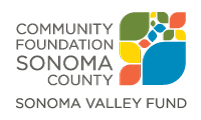We’ve heard the proverb “Give a man a fish and you feed him for today; teach a man to fish and you have fed him for a lifetime.”
Nonprofit organizations live and breathe this mantra every day in their own work with clients. From helping teens build job skills, to connecting students who want to create art with art teachers, nonprofit organizations help people develop their own capacity to do more for themselves.
But how do nonprofit organizations find the time to develop their own capacity for improvement? This question is at the heart of the Sonoma Valley Fund’s capacity building grants program, which offers funding to give organizations the time and resources to work on themselves.
Launched in 2016, the first cohort of nonprofit organizations is now entering their third year of a shared capacity building program. For the past two years, the leaders of Art Escape, La Luz, Sonoma Valley Mentoring Alliance, Sonoma Overnight Support, Teen Services Sonoma, and Boys & Girls Clubs of Sonoma Valley have met quarterly under the guidance of a consulting team from Informing Change to learn from each other and develop their programs, staffing models, and data collection practices.
For Art Escape, participating in the capacity building cohort has been transformative. Art Escape, located in Boyes Hot Springs, offers free art projects for parents and children, weekly after-school art classes for elementary school students, and more. They began in 2012 with a modest budget of just $19,000 and have since grown to a budget of $200,000 this year.
Kate Ortolano and Thena Trygstad, two of the volunteer co-founders of Art Escape, explain that when they first applied for a capacity building grant, the art program was entirely volunteer run, and their participation in the capacity building cohort enabled them to reflect on the need for creating paid staff positions and growing their board as they continue to expand. “In terms of the cohort, we are the smallest of the six organizations that were chosen.
“We felt extremely lucky we’ve had the opportunity to learn so many things, and to learn not to make mistakes that we have learned from exposure to other organizations.”
Helping teens build their own capacity is the focus at Teen Services Sonoma, where youth engage in work experience programs to prepare them for future careers in a variety of fields. Executive Director Cristin Felso says that one of the first steps her organization took as a member of the cohort was to work together with other youth-serving agencies, Mentoring Alliance and the Boys & Girls Clubs.
“We have interacted with these other organizations for years, but now we have a roadmap for how to truly partner in a meaningful way.” Through the capacity building cohort, these three organizations came together to develop a better system for collecting data within their own agencies, as well as sharing information across agencies. “One of the things we are seeing in this data is that we are each unique, and we serve youth in different ways, but we can now see (with data) that when our programs crossover, we can better serve our youth and create stronger outcomes.”
For Cristin Felso, the value of this capacity building grant is clear, “There are a number of youth-serving organizations in Sonoma Valley; all of us hear from donors that they want us to collaborate. The data we are collecting will help us to do just that and assures that we are providing a continuum of services. This better serves our youth and opens up new avenues for funding streams as well.”
The best part of the capacity building cohort? It’s the long-term effects of having helped this community of nonprofit leaders learn to fish together. Kate Ortolano explains, “We now have relationships that wouldn’t have been fostered if we didn’t have this opportunity. Now we’re looking at how to continue these relationships in the future and talking about how to support each other instead of being competitors.”




























